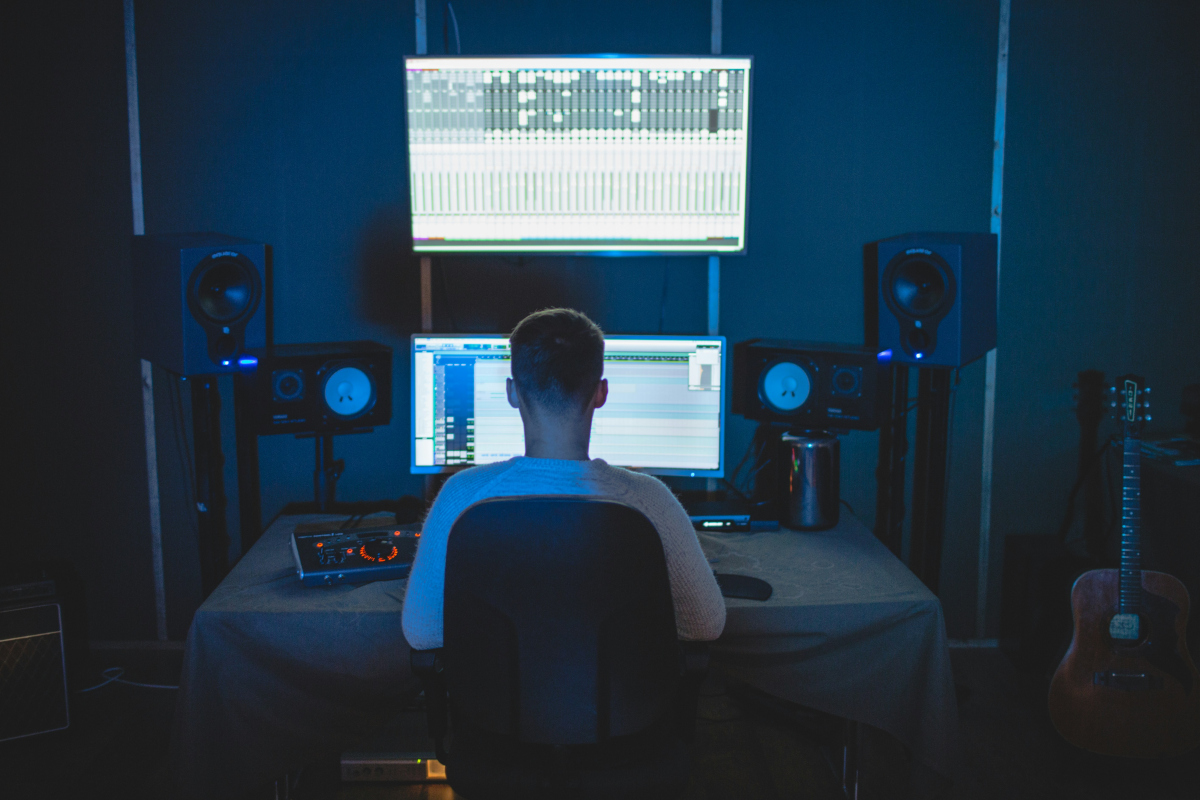Ever wondered what makes studio monitors the go-to choice for professionals in the audio industry? They’re not just your regular speakers. Studio monitors are engineered for precision, designed to deliver uncolored, natural playback of recorded material. This makes them ideal for critical listening, recording, mixing, editing, and mastering audio to a professional degree. (Photo by James Owen on Unsplash)
Discover GRAMMY GO courses exclusively on Coursera
But, these high-quality devices may not be the first choice for the everyday music lover. Their pro-level intricacies and higher price tag can be a deterrent. But don’t fret! The rise of home recording studios has spurred a market for budget-friendly studio monitors that are accessible to aspiring musicians and producers.
Whether you’re a seasoned sound engineer or music producer, or a budding audio enthusiast, understanding studio monitors is key to achieving exceptional sound quality. Let’s investigate into the world of studio monitors and unravel their unique features and benefits.
What are studio monitors?
Learn about music production essentials and you’ll encounter studio monitors, a crucial tool for producing audio of the highest quality. Studio monitors, unlike ordinary speakers, exhibit remarkable fidelity in their sound reproduction. Natural playback is their strong suit, replicating recorded material without introducing any extra color to the sound.
If precision is what you’re after, studio monitors are tailor-made for critical listening. They shine in environments geared towards professional usage, such as recording and radio studios, as well as television. Notably, they’re deemed the top choice when it comes to mixing, editing and mastering audio to a professional degree.
It’s important to understand, but, that studio monitors adhere to the needs of professionals and may not sit well with regular music connoisseurs. This is mainly due to the intricate professional-level features that define them and a higher price point that reflects their premier build quality and the use of premium components. That said, the market for studio monitors has diversified. Nowadays, budget-friendly options catering to home studios are also available.
For larger studio environments, there are studio monitors designed specifically for midfield or farfield use. These typically come with larger woofers of approximately 12 inches or more. Not only are they perfect for expansive spaces, but they also enhance the width and sound breadth, offering optimal sound quality.
Remember, studio monitors are an investment. If you’re serious about professional audio production or critical listening, they provide an accuracy and fidelity that is truly unmatched. They might be pricier compared to conventional home stereo speakers, but they’re a smart investment for anyone seeking exceptional sound quality.
Studio Monitors vs Hi-Fi Speakers
Understanding the fundamental differences between studio monitors and Hi-Fi speakers helps hone professionalism in sound reproduction tasks. While Hi-Fi speakers color your music and enhance listening pleasure, studio monitors aim for a truthful, flat response. They offer unaltered, precise audio playback, revealing every detail essential for critical listening and accurate music production.
For instance, an UE MEGABOOM Bluetooth speaker, a type of Hi-Fi speaker, does a great job in mixing. Yet, it’s not a monitor. The mix you hear on consumer speakers such as these will differ substantially. Sound from studio monitors, on the other hand, allows you to hear reverb better, produces less exaggerated bass, and provides a more segregated, quicker audio response, like the NS10M Studios.
Even though their higher cost compared to consumer speakers, studio monitors like NS10M Studios hold an advantage with their sealed box structure. This setup means less bass smear from reflex ports— ensuring cleaner, more accurate audio.
Also, Hi-Fi monitors that turn into studio monitors, though not commonly found, might succeed in offering revealing and accurate audio. Recognition of these fundamental variances is essential for making informed choices in audio production and sound engineering.
What are studio monitors used for?
Comprehensive knowledge about tools is essential for a successful career in the music industry. You’ll often encounter studio monitors during recording sessions and sound mixings. They serve as integral tools in professional audio production and critical listening applications, offering accuracy and fidelity. They are designed to give you an honest representation of what is actually in your mix. Hence, understanding where and when to use them will be beneficial. Let’s investigate into their applicability in different scenarios.
Are studio monitors good for listening to music?
Yes, studio monitors provide a detailed, accurate, and uncolored representation of audio content. In other words, they offer an honest sonic portrayal that’s essential for music professionals. Especially when processing audio data such as mixing or mastering tracks, these tools allow engineers to make precise modifications to the sound.
Contrary to conventional speakers, these monitors are purpose-built to provide flat frequency response. This flat output aids in revealing intricate details and nuances embedded in the music, missing in conventional speakers. For instance, entry-level studio monitors like KRK Rokit 5 offer a sonic accuracy that’s hard to find in speakers of similar price range.
But, for casual listening where audio judgment isn’t critical, conventional speakers might be more desirable as they often sweeten and enhance the audio.
Are studio monitors good for gaming or movies?
Studio monitors aren’t typically associated with gaming or movie watching. But, they can be potentially beneficial, largely depending on the specific use case.
In gaming, sound produces vital cues that enhance your overall experience. Hence, the precise audio delivery by studio monitors can potentially enhance gaming experiences by providing crystal clear sound details.
In terms of movies, studio monitors can be particularly beneficial when viewing content where audio precision is crucial. Because of their flat frequency response, they provide sharp audio details enhancing dialogues’ clarity, sound effects, and the overall soundscape of a film.
But, when it comes to producing a broad surround sound, which is often desirable in a cinematic home setup, studio monitors might not be the best fit. Conventional home theater systems are often designed to create this immersive audio experience typically sought in movie viewing.
Remember, while studio monitors present an accurate sonic image that’s critical in audio production, these benefits may or may not translate into improved gaming or movie-watching experiences. Assess your priorities, understanding the strengths, and unique features of studio monitors enable you to make an well-informed choice.
Are studio monitors worth it?
Definitely, studio monitors prove essential in professional, precise audio production. They offer an accurate, untainted representation of sound, displaying audio in its purest form. For instance, Studimon 5, a model frequently adopted by audio professionals, best exemplifies this accuracy promise. Its placement setup, featuring the utilization of high-quality stands, such as those produced by Gravity, reinforce audio quality, ensuring stability and minimizing vibration interference.
You’ll find some monitors, like the Fluid Audio Image 2, highly favored in the industry. Flaunting a wide frequency range with minimal harmonic distortion, it’s a prime choice for recording and mixing applications. Another esteemed brand is ATC, lauded for its remarkable clarity and precision. These monitor brands solidify why studio monitors are valuable in the audio industry.
But, its worth lies outside raw audio production tasks too. Crucial for other professional settings demanding critical listening, such as gaming and film production, they offer better detail and clarity in sound, enhancing the experience.
It’s important to comprehend, though, that buying a studio monitor is a worthy investment only if you prioritize accurate audio reproduction. It might not fulfill casual listening needs where an emphasis on bass or treble might be more appreciated. Hence, assess whether the true, detailed sound delivered by studio monitors harmonizes with your sonic preferences and needs before investing.
How to set up studio monitors
Setting up your studio monitors properly plays a fundamental role in achieving the best sound quality for your mixes. Positioning and acoustic treatment are key factors that can greatly impact the performance of your studio monitors. These steps will guide you in creating an optimal listening environment in your home or professional studio.
- Select an Appropriate Room
Favor a room that is neither too small nor too big, and has few windows, doors, and mirrors. It’s best you choose a room with asymmetric walls, as symmetric rooms can create unwanted reflections and standing waves that can distort the sound produced. - Ideal Positioning
Place your monitors in an equilateral triangle formation with your listening position. In other words, each monitor should be the same distance apart from each other as they are from you. The tweeters should be at ear level and directed toward your listening position. - Acoustic Treatment
Install bass traps in corners, as low frequencies tend to build up in these areas. Use diffusion and absorption materials to manage reflections and echoes. This way, you’re solving any potential acoustical issues that might distort the sound in your room. - Proper Connection
Connect your studio monitors to an audio interface or mixing console, and make sure the cables are long enough to reach from your audio device to the monitors’ position. - Calibration
Adjust the volume and equalization settings of your studio monitors until you achieve the flattest frequency response, which is ideal for accurate audio reproduction.
By following these steps, you’re establishing the groundwork for accurate sound reproduction, enabling you to create mixes that will sound great on any sound system.
How to position studio monitors
Correct positioning of studio monitors is crucial for achieving accurate sound reproduction. It requires particular attention to factors such as the distance of monitors from the wall and from each other. Following certain guidelines can help optimize your setup and ensure the best possible audio quality.
How Far Should Studio Monitors Be from the Wall?
Consider the impact of your room’s acoustics when placing your studio monitors. Positioned too close to the wall can cause an excess reflection, distorting the sound output due to comb filtering effect. It can lead to unnatural boosts or cuts in certain frequencies, affecting the quality of your mix.
Typically, a safe distance is to place your monitors at least a foot (30.48 cm) away from the wall. This distance varies based on the individual monitor’s design and the room size and its acoustics. Don’t forget to ensure your monitors aren’t too distanced from each other.
How Far Apart Should Studio Monitors Be?
The distance between your studio monitors impacts the stereo imaging significantly, affecting how you perceive the sound spatially. A widely accepted rule is the equilateral triangle rule. This rule entails positioning the monitors and your listening position (head) in such a way that they form an equilateral triangle. It means the distance between the monitors should be equal to the distance from each monitor to your listening position.
For example, if your monitors are 5 feet (1.52 meters) apart, your head should also be 5 feet (1.52 meters) from each monitor. This setup can help achieve the best stereo imaging, ensuring that you perceive the audio’s depth, width, and details accurately. But, the ideal distance also depends on your room’s size and shape, so tweaking and testing are often necessary for optimal setup.
Remember, proper positioning of your studio monitors are critical steps in creating accurate mixes that sound good on any playback system. Take time to adjust your setup according to your specific context to maximize your monitors’ performance.
Popular studio monitors
Studio monitors, known for their precision and clear audio representation, have several models that stand out in the market. Each of these shining examples offers a unique blend of features, and cater to a different range of budget and requirements.
- M-Audio BX4: Popular among budget-conscious mixers, the M-Audio BX4 delivers articulate sound for less. This cost efficiency doesn’t imply a compromise in quality, making it a gateway for aspiring musicians and producers.
- Adam Audio T5V: Falling within the $500 budget category, these monitors surprise with their precise top end. If you’re inclined towards mixing, the Adam Audio T5V offers great value for your investment.
- KRK Rokit RP7 G4: Known for its distinctive yellow cones, this visually appealing model is packed with features and ideal for smaller home studio setups. It’s a favored choice for electronic music production, enhancing sonic experience in a home environment.
- Yamaha HS5: Finally, Yamaha’s HS5 monitors offer robust production support, further cementing their place in the list. Noteworthy for their balance and detailed sound, this model serves as a reliable tool in any audio professional’s kit.
Choosing the right studio monitor is crucial in shaping your music production journey. Consider the individual prowess of each of these models and make an well-informed choice in line with your audio production aspirations.




















